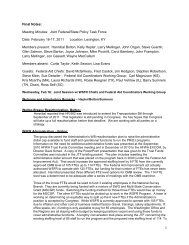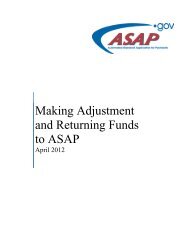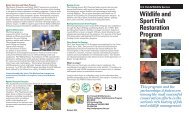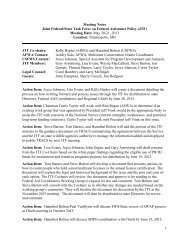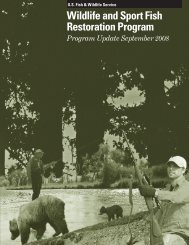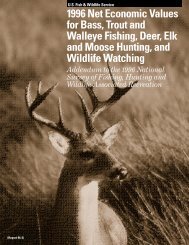Financial Returns To Industry From The Federal Aid - Wildlife and ...
Financial Returns To Industry From The Federal Aid - Wildlife and ...
Financial Returns To Industry From The Federal Aid - Wildlife and ...
Create successful ePaper yourself
Turn your PDF publications into a flip-book with our unique Google optimized e-Paper software.
<strong>and</strong> 2006. <strong>The</strong>se online state-level reports do not provide the same level of detailed<br />
hunting equipment purchases that is reported at the national level, but can be estimated<br />
following the assumption that the purchasing pattern for the average migratory-bird<br />
hunter in Virginia is similar to other hunters across the nation. As a result, equipmentrelated<br />
purchases are estimated for Virginia using the national percentage of total<br />
hunter spending that is allocated to tax-related equipment items relative to total<br />
spending (2001: 21% <strong>and</strong> 2006: 17%). Average purchases per hunter day are $14.52<br />
for 2001 <strong>and</strong> $8.62 for 2006, in current day (2009) dollars <strong>and</strong> adjusting for a 30%<br />
market chain markup. 13<br />
Table 4. Virginia’s Resident Canada Goose Hunting: Annual Tax-Related<br />
Investments, Purchases <strong>and</strong> <strong>Returns</strong> (2009 $s)<br />
Year<br />
Annual <strong>Wildlife</strong> Annual Tax Related Annual Excise<br />
1999 Restoration $19,316.06 Funds Equipment Purchases $391,658 Tax-Related 1928% ROI<br />
2000 Invested $18,687.89 $647,393 3364%<br />
2001 $18,170.84 $1,033,435 5587%<br />
2002 $17,888.02 $930,516 5102%<br />
2003 $17,489.43 $733,804 4096%<br />
2004 $17,035.76 $661,717 3784%<br />
2005 $16,477.50 $624,306 3689%<br />
2006 $15,962.57 $521,440 3167%<br />
2007 $15,520.52 $588,391 3691%<br />
2008 $14,946.63 $632,228 4130%<br />
2009 $15,000.00 $632,228 4115%<br />
Average Annual $16,954.11 $672,464.94 3877%<br />
An important assumption is that hunter effort is spread equally across all seasons. This<br />
is not likely the case because the daily bag limit for the regular season is 2 or 3 birds<br />
depending on the hunting zone; the daily bag limits for the extended season is 10<br />
birds/day in September <strong>and</strong> 5 birds/day in the late season. This increased opportunity<br />
for harvest is likely to have increased participation during the extended seasons.<br />
Evidence does suggest that industry has recouped their investment in research <strong>and</strong><br />
management of resident Canada geese in Virginia <strong>and</strong> continues to earn positive<br />
benefits on annual investments. In fact, in 2009 alone, migratory-bird hunters spent an<br />
estimated $623,228 on tax related items based upon hunting days spent in Virginia.<br />
This is a marked increase ($240,570) in annual purchases relative to spending by<br />
goose hunters in 1999 ($391,658).<br />
When reviewing the return on investments, it is also critical to remember that efforts<br />
across the flyway <strong>and</strong> within Virginia, in particular, extend well before 1999. <strong>The</strong> period<br />
highlighted reflects a period that might be described as the later portion of recovery<br />
when returns on investments tend to be larger as direct monetary investments trend<br />
13 Intervening years are estimated using simple linear interpolation.<br />
37




